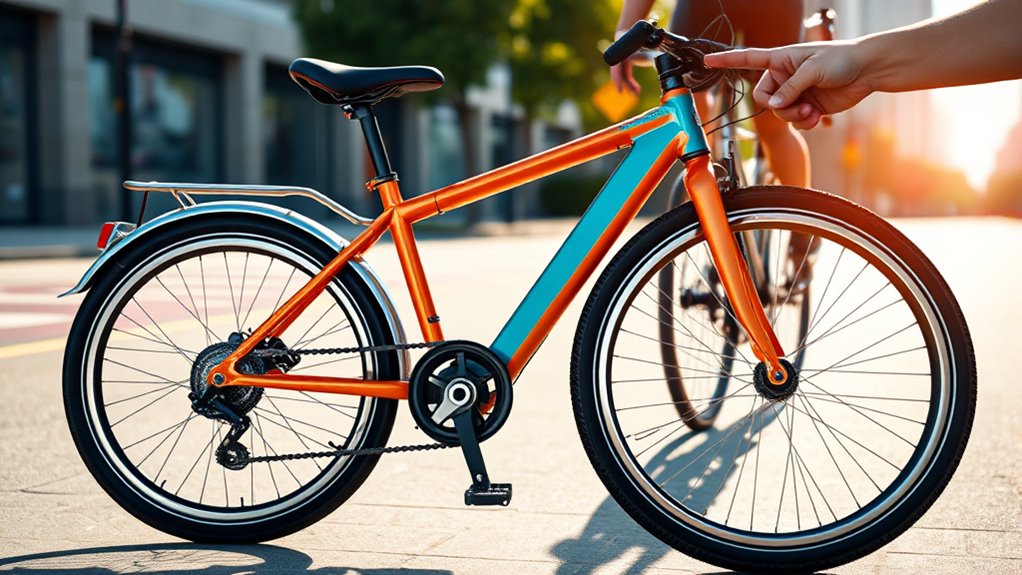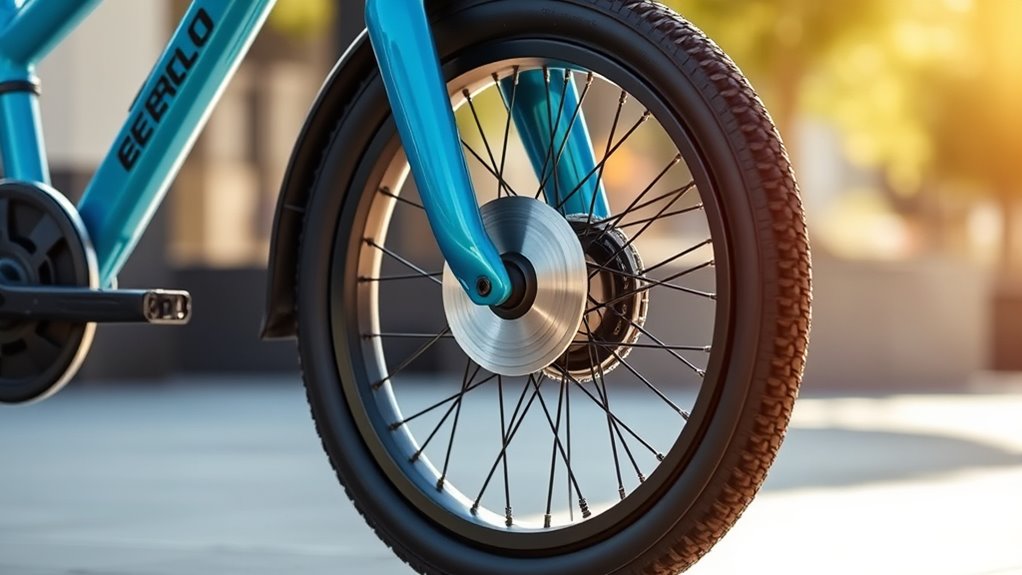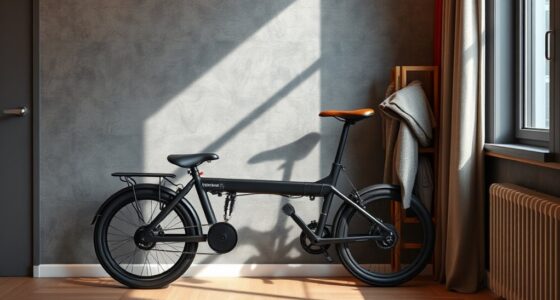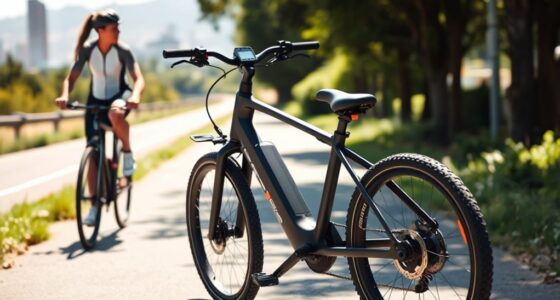Choosing between 16“, 20″, or 24” wheels for your portable e-bike depends on your needs. If you want a lightweight, compact option for quick errands, go for 16″. For a balance of portability and comfort on city streets, 20″ wheels work well. If you plan longer rides or tackle rough terrain, 24″ wheels provide better stability and range. To find the perfect fit for your lifestyle, consider how each size matches your typical riding habits.
Key Takeaways
- 16-inch wheels offer maximum portability and quick maneuverability, ideal for short errands and urban commuting.
- 20-inch wheels balance ride comfort and portability, suitable for city riding and mixed terrains.
- 24-inch wheels provide better stability and longer-range capability, best for extended rides and diverse terrains.
- Smaller wheels require less motor power and battery capacity, making the bike lighter and more agile.
- Larger wheels enhance ride stability and range but increase overall size and weight, reducing portability.

Are you trying to decide between 16-inch, 20-inch, or 24-inch wheels for your portable e-bike? The size you choose impacts more than just the look; it affects ride quality, portability, and performance. When considering wheel size, two essential factors to keep in mind are battery capacity and motor power. These elements work together to determine how far you can go and how much power you have to tackle hills or headwinds.
Smaller wheels, like 16-inch, are excellent for portability. They make your e-bike compact and easy to carry or store in tight spaces. However, they often require less motor power because they roll over obstacles more easily and maintain momentum better at lower speeds. Still, because smaller wheels usually mean a smaller frame, you might find that your battery capacity is limited, reducing your overall range. If you plan to commute short distances or need a lightweight bike for quick errands, 16-inch wheels make sense, but you should consider whether the motor and battery can support your desired travel distances.
16-inch wheels are ideal for portability and quick errands but may limit range due to smaller batteries.
Moving up to 20-inch wheels, you strike a good balance. These wheels provide a smoother ride over uneven surfaces and potholes, which is especially helpful if you ride on city streets or mixed terrain. With a slightly larger wheel, you can opt for a more powerful motor without substantially sacrificing portability. This means you can select a battery with higher capacity, extending your range without adding excessive weight. If your riding involves longer trips or hilly terrain, 20-inch wheels allow you to choose a motor with more torque and a bigger battery, giving you both power and endurance. Additionally, the wheel size can influence your overall riding experience and comfort, especially over longer distances.
Finally, 24-inch wheels are closer to traditional bicycle sizes, offering increased stability and comfort for longer rides. They tend to require more motor power to accelerate and climb hills, so your e-bike needs a robust motor to maintain performance. Larger wheels often mean a bigger frame and more weight, which can impact portability. But in exchange, you get a greater battery capacity and motor power, translating into extended range and better ability to handle challenging terrain. If you’re planning on longer commutes or exploring diverse environments, 24-inch wheels might be worth the trade-off in size and weight.
Frequently Asked Questions
How Does Wheel Size Affect E-Bike Battery Life?
Wheel size impacts your e-bike’s battery efficiency and ride comfort. Larger wheels typically improve battery life because they roll more efficiently, reducing effort and energy consumption. They also offer a smoother ride, which can help conserve battery by minimizing vibrations and jolts. Smaller wheels might drain the battery faster due to increased resistance, but they provide better maneuverability. Choose the wheel size that balances your need for comfort and best battery use.
Are Smaller Wheels Better for Urban Commuting?
Think of smaller wheels like nimble dancers weaving through city streets—they excel in tight spaces and quick turns. Yes, they’re ideal for urban commuting because they offer better tire grip on slick surfaces and add to the bike’s aesthetic appeal with a sleek look. You’ll find that smaller wheels make your ride more responsive, perfect for maneuvering busy streets, making your daily commute smoother and more enjoyable.
Can Larger Wheels Handle Rough Terrains More Effectively?
Larger wheels handle rough terrains better because they offer improved tire traction and suspension performance. They roll over obstacles more smoothly, reducing jolts and maintaining stability. With better traction, you get a secure grip on uneven surfaces, making your ride safer and more comfortable. So, if you frequently ride off-road or on rough trails, opting for bigger wheels helps you conquer challenging terrains more effectively.
How Does Wheel Size Influence E-Bike Speed and Acceleration?
Think of your e-bike as a rocket: the larger the wheel diameter, the more it can punch through the air. Bigger wheels reduce rolling resistance, helping you reach higher speeds faster and accelerate smoothly. Smaller wheels, meanwhile, offer quick agility but might lag in top speed. So, your wheel size directly influences your e-bike’s speed and acceleration—larger wheels boost both, making your ride feel more powerful and efficient.
Is Wheel Size Choice Different for Folding Versus Standard E-Bikes?
When choosing wheel size, folding e-bikes often prioritize smaller wheels for better portability and compactness, making them easier to fold and carry. Standard e-bikes tend to have larger wheels, offering better stability and ride comfort but less portability. Your choice depends on your main use: if portability matters most, go for smaller wheels on a folding e-bike; if comfort and range are key, larger wheels on a standard model suit you better.
Conclusion
Choosing the right wheel size depends on your riding style and portability needs. While smaller wheels like 16″ are easiest to carry and maneuver, larger wheels such as 24″ offer better stability and performance. Curiously, some studies suggest that wheel size can influence energy efficiency and ride comfort more than we might expect, challenging the idea that bigger always means better. Ultimately, consider how you plan to use your e-bike to find the perfect balance between convenience and ride quality.









